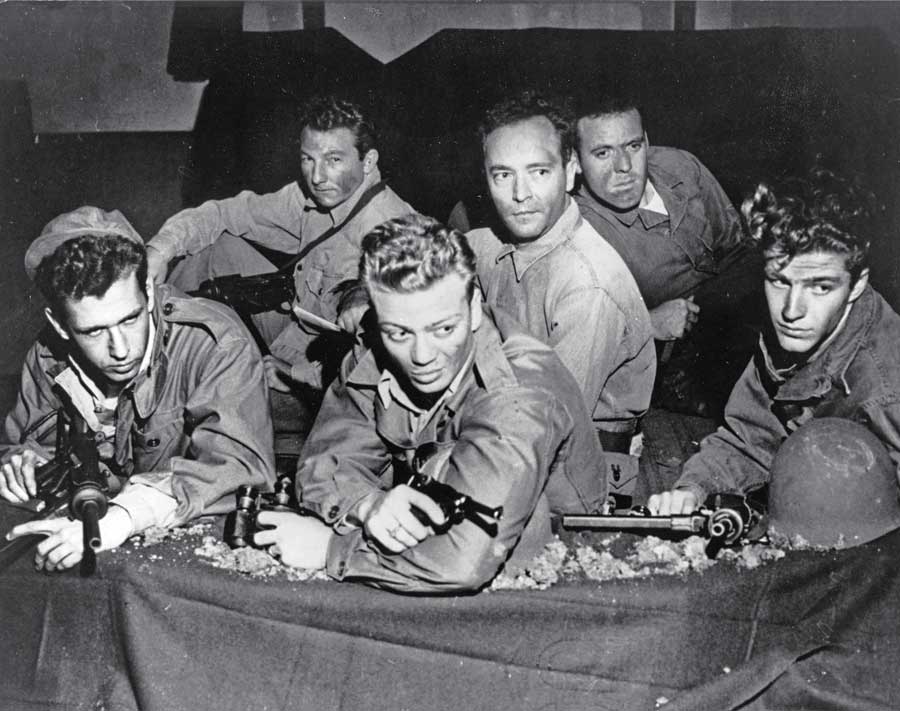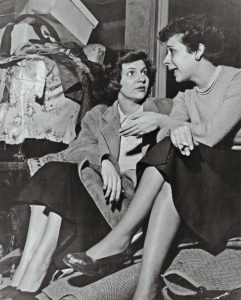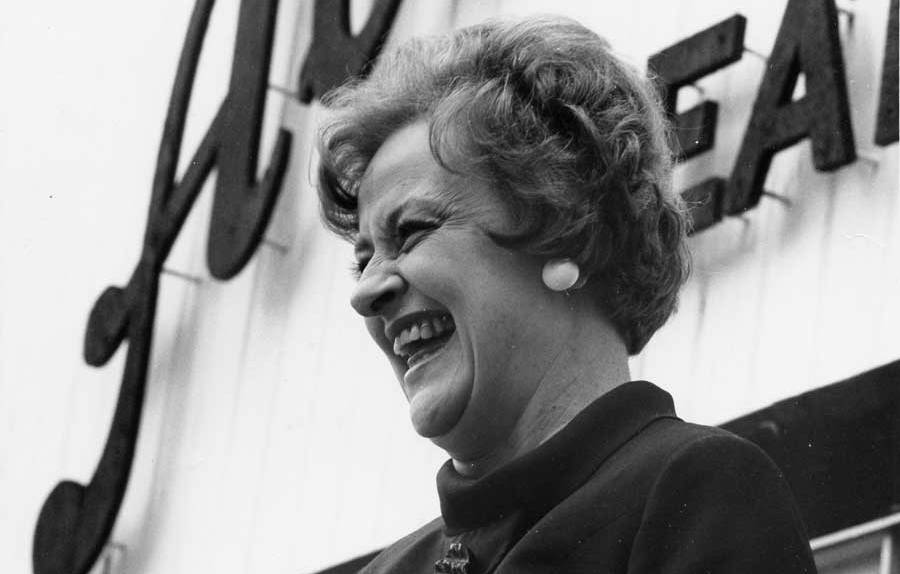Walk up the grand staircase outside the concrete castle in Houston that is the Nina Vance Alley Theatre, walk through the doors, and look to your right. There’s a portrait of the theatre’s namesake: She’s well-coiffed, a little imposing, with a mysterious smile and a gleam in her eye. She looks like Texas. Her legacy in Houston is without parallel, and so was her impact on the American theatre.
Born in Yoakum, Texas, in 1914 to Calvin Perry (C.P.) Whittington and Sue Minerva DeWitt Whittington, she was a direct descendant of two of the earliest immigrants from the Eastern states to Texas: Green DeWitt and Benjamin Beeson. Nina (pronounced “Nine-a”) would spend nearly all of her life in the Lone Star State, and she would take the pioneering spirit of her forefathers into a new realm. What began with a few classes she taught at a Jewish Community Center when she was 30 years old grew over time into one of the great regional theatres in the U.S.
The career path for smart and ambitious young women of her time was limited at best, but she found a route through the stage. A theatre lover from early on, she appeared in plays at Texas Christian University, where she received her B.A. in public speaking in 1935 (they offered no degree in theatre). She went on to study briefly at Columbia University in New York and at the University of Southern California in Los Angeles, where she also took on several extra parts in movies. When she moved back to Texas in 1939, Vance got a day job as a teacher in Houston at Jefferson Davis High School, while at night she volunteered at the Houston Community Players. The troupe was led at the time by Margo Jones, another Texas woman who would have an outsized impact on the American theatre. Jones had a profound influence on Vance, particularly her view that professional theatre was possible, and necessary, outside New York.
Everyone who worked with Jones did so under strict rules of professionalism: If you were one minute late, you were out. Another big influence on Vance was Jones’s preference for arena staging. In an interview from 1971, Vance describes her relationship with Jones as not at all close—that she was merely an observer of her colleague’s brilliance, and that Jones (who had died in 1955) probably wouldn’t even have remembered her.
The Houston Community Players disbanded in 1944 because, with World War II raging, there weren’t enough male actors on hand to fill the roles. When the local JCC invited her to teach classes there, Vance agreed on the condition that she also could direct plays there. It was there that she met Vivian and Bob Altfeld, who ran a successful dance studio. She said later that though she did not realize she was entering a profession, it was the constant prodding from the Altfelds and others who, like her, were dissatisfied with Houston theatre’s status quo that led her to agree to forming a new theatre for the East Texas city.
Vance was on board but wasn’t sure she had the support she would need. That’s when she mailed the now legendary 214 penny postcards to 214 Houston citizens, asking them if they wanted a new theatre for Houston. If they did, the postcard said, they should come to a meeting. More than 100 people showed up, far more than she anticipated. A theatre was born that night, with the Altfelds offering their dance studio for performances—with three conditions. First, Vance’s new troupe would have to reckon with a tree that grew straight up through the studio and could not be removed. Second, what did have to be removed was all evidence of theatrical production every night so that dance classes could proceed in the morning. Finally, there was no heating or cooling.

Those early enthusiastic citizens became supporters, and the name was chosen by a vote—as the entrance to the dance studio was down an alley, hence the Alley Theatre. Vance didn’t like the name; it sounded too bohemian to her, and she thought bohemianism smacked of unprofessionalism, an opinion that would remain unchanged throughout her life. The theatre’s first performance was on Nov. 18, 1947, of a play by Harry Brown called A Sound of Hunting, staged in an arena configuration by Vance.
But this early Alley was short-lived. After only one-and-a-half seasons, the theatre was shut down by the fire marshal. A new space was found, and an angel donor offered to cover half the cost of construction if the other half could be raised. Vance and her team raised the money, and a converted electric fan factory on Berry Avenue became the second Alley location. The building is gone now, but photos show a stylish space, also with an arena configuration. The only trouble? There was no alley. You’d think that Vance would take this opportunity to change the theatre’s name; instead an alley was created to match the name.
This iteration of the Alley achieved success right out of the gate. Writing about Houston theatre for The New York Times in 1949, Hubert Roussel called Nina “a fine and imaginative director.” The opening play, on Feb. 8, 1949, was The Children’s Hour by Lillian Hellman. In the cast, among others, were Pat Brown and Jo Alessandro Marks, both of whom would remain involved with the Alley until after Nina’s death. In late April 1950, it was announced that the Alley production of Light Up the Sky had run for 36 performances, the longest run in Houston history, and played to near capacity.
When, in 1952, Brooks Atkinson, theatre critic for The New York Times, made his first visit to the Alley, he found Nina’s production of Miss Julie to be “discerning, neatly balanced and attractive.” It was also Atkinson who suggested to W. McNeil “Mac” Lowry of the Ford Foundation that he visit the Alley. He came in 1957 and immediately saw the potential in Vance, the Alley, and Houston. In 1959 the Ford Foundation awarded her a travel and study grant, an honor afforded to only 10 directors in the nation. She sailed from New York to Europe, and her journals from that time evoke an exciting and glamorous trip abroad, meeting other directors and producers and seeing shows across the continent.
Lowry also selected the Alley to be one of only four theatres in the country to receive a Ford grant to support a resident acting company. (The company began as an all-volunteer effort, not signing their first Equity contract until 1954.) The grant was meant to support actors so that they would be able to work in Houston for up to a full year without having to worry about missing out on work in New York or Los Angeles. Though that program would eventually be discontinued, Mac continued to visit Houston and to believe in the potential of the Alley. In 1962, the Ford Foundation announced that it was making a grant to the Alley for $2.1 million (around $18 million in 2019 dollars) million for the construction of a new Alley Theatre.

Nina has been described as an “artist/builder,” which in many ways refers to her leadership of the construction in 1968 of the Alley Theatre building we know today. But from the start she was also building community and relationships. It was here that Mrs. Victor Alessandro (Josephine) started work as the box office manager; she would volunteer for many years in that capacity. Iris Siff and her husband were another two of the first volunteers. Siff would step into the leadership role after Vance’s death in 1980, and would work at the Alley until her own death in 1982.
Indeed while there were plenty of men who worked at the Alley over the years, making significant contributions both as volunteers and paid staff, it was the women who stuck around the longest. Speaking about the women mentioned above, as well as Bettye Fitzpatrick—a company member for more than 50 years—Vance once said, “So many women engaged in this theatre had little if anything to do with the fact that I am a woman. It has more to do with the fact that men are more ambitious to get to a greater seat of power than Houston looked to be, and women were excluded from the New York theatre.”
Vance didn’t just build the Alley; she worked hard to sustain it, and through some trying times. The move in the mid-’50s from an all-volunteer to a paid company, for instance, proved controversial, as some fought the move to professionalism; Vance would recall this period as a time of “chaos, change, and hurt feelings.” And in 1975 it was discovered that the theatre owed thousands of dollars of back taxes on a parcel of the theatre’s land that didn’t have the tax exemption they thought it did.
Vance’s notes and correspondence throughout her career indicate that she felt the burden of fiscal responsibility acutely and always. In interviews she never shied away from a discussion of money. In 1969 she wrote to Lowry, saying, “Every day there is responsibility for the money, so there is never a free day.” Her day planners from 1968 through the ’70s are in her archives; they list actors, directors, technical directors, lists of plays, grocery lists, menus, records of what she wore. One note from a staff meeting reads: “You don’t have to like one another but you do need to keep your mouths shut.” Another seems to be addressed to herself: “Don’t be intimidated.” Her papers show a busy and creative mind that was not without its demons.
When the new Alley opened on Nov. 26, 1968, Vance said it was important that the building work “for directors for 50 to 100 years to come.” While several renovations and large-scale changes have been made to the theatre—including in response to flood damage in recent years—her ambition has been realized. Her notes from the time, and the correspondence between her and architect Ulrich Franzen, show that no detail was too small to escape her care but that she never lost sight of the big picture. “This building must not look like a bank or a store or a post office—it is a house—a house of dreams.”
Catherine Essinger, a librarian at the University of Houston who recently co-curated an exhibition about Vance and the Alley, describes its founder the following way: “She focused on goals, details, and dreaming big. She didn’t focus on what she thought she could do. She didn’t limit herself.”
Not everyone loved everything she did. Ann Holmes, critic for the Houston Chronicle, described the first show at the new Alley, Galileo, as “a resounding flop,” and called its entire first season “tepid.” Indeed “too safe” was a recurring criticism of Vance’s tenure as a programmer. She countered that by saying she understood her audience and how far they could be pushed. Her papers, especially from the ’60s and ’70s, show list after list of plays, sometimes with the same play appearing year after year but never being produced. She directed the same passion and intensity toward play selection as she did to everything else, and her audience was her first concern.
Charles Kohn, an actor who worked several times with Vance and who still works at the Alley, describes her approach as springing “from a vision of what a theatre should be, and that vision extended to the audience. She saw the theatre as a kind of church, harkening back to miracle and morality plays, and that included the audience.”
After Vance died in 1980 of cancer, the Alley continued to grow, drawing large audiences and racking up such milestones as a regional Tony Award, co-productions with London’s National Theatre, and a major renovation. There was also tumult in succeeding years: In 1982, managing director Iris Siff was murdered by a former Alley security guard, and in 1988 artistic director Pat Brown was summarily dismissed; she later sued the theatre. In 2018 her successor, Gregory Boyd, departed around the same time that persistent allegations of abusive behavior came to light.
Through all the ups and downs, though, Vance’s legacy remains unshakable. Says Dean R. Gladden, the Alley’s managing director since 2006, of the founder’s reputation: “She was not a person of wealth, she was a person of the theatre, and because of that she is held in continuous high regard.” He says that the theatre lives with Nina every day. They talk to every new employee about her and they always want to live up to her high standards. “The Alley,” he concludes, “is Nina’s theatre.”
Deb Clapp is the executive director of the League of Chicago Theatres.


